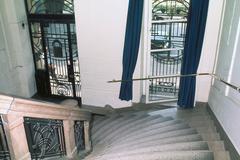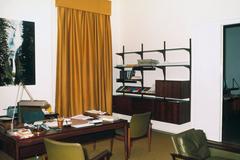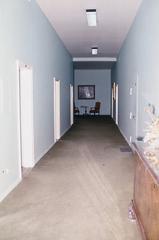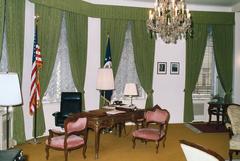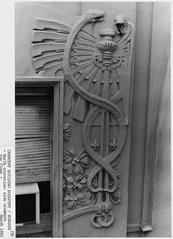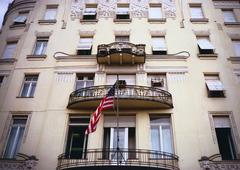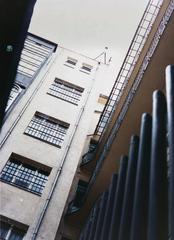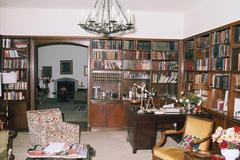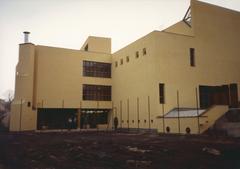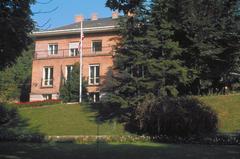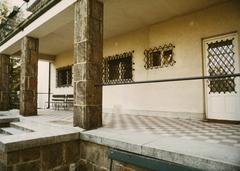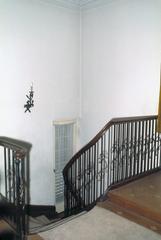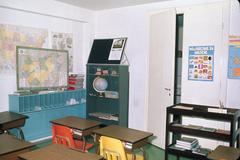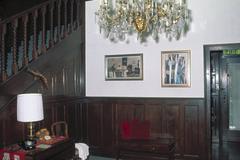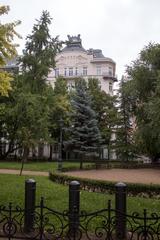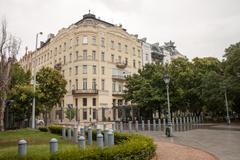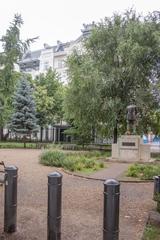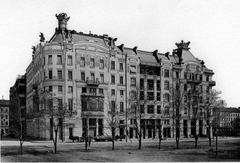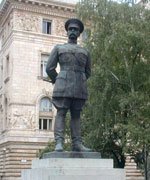
Embassy of the United States Budapest: Visiting Hours, Tickets, and Visitor Guide
Date: 14/06/2025
Introduction
The U.S. Embassy in Budapest stands as a testament to over a century of American-Hungarian diplomatic engagement, humanitarian acts, and cultural exchange. Located at Liberty Square (Szabadság tér 12) in the heart of Budapest’s Fifth District, this embassy not only functions as the nexus for bilateral relations but also occupies a site of immense historical and architectural significance. This guide delivers detailed information on the embassy’s history, visitor protocols, nearby attractions, and practical travel tips, ensuring a comprehensive and enriching experience for anyone interested in Budapest’s diplomatic and cultural heritage (U.S. Department of State; State Magazine; Wikipedia).
Table of Contents
- Introduction
- Historical Significance of the U.S. Embassy Budapest
- Architectural Importance and Location
- Practical Visitor Information
- Frequently Asked Questions (FAQ)
- The Embassy’s Role in Contemporary U.S.-Hungarian Relations
- Conclusion and Final Tips
- Sources
Historical Significance of the U.S. Embassy Budapest
Origins and Diplomatic Milestones
Diplomatic ties between the United States and Hungary were officially established in 1921 following the breakup of the Austro-Hungarian Empire. The embassy, housed in the former Hungarian Commercial Hall (inaugurated in 1901), became a focal point for fostering political, economic, and cultural links throughout the 20th century (Wikipedia).
During World War II, relations were severed after Hungary declared war on the U.S. The embassy famously served as a humanitarian refuge, with Swiss Consul Carl Lutz, operating under Swiss protection, saving tens of thousands of Hungarian Jews from deportation. His actions are commemorated by a nearby memorial (State Magazine; U.S. Embassy Budapest).
In the Cold War era, the embassy provided sanctuary to political dissidents, most notably Cardinal József Mindszenty, who lived there for 15 years after the 1956 Hungarian Revolution. The embassy also played a pivotal role in Hungary’s post-communist transition, supporting the country’s accession to NATO (1999) and the European Union (2004) (Wikipedia).
Architectural Importance and Location
The embassy’s location on Liberty Square situates it among Budapest’s most prestigious architectural and governmental landmarks. While specific details of the embassy building remain classified for security, the surrounding district features a rich blend of Neoclassical, Neo-Gothic, Neo-Renaissance, and Neo-Baroque architecture, reflecting the city’s historical prosperity and adaptation following wars and political upheaval (Offbeat Budapest; Architecture of Cities).
Practical Visitor Information
Visiting Hours and Appointments
- Operating Hours: Monday to Friday, 8:00 a.m. – 4:30 p.m.
- Closed: Saturdays, Sundays, and U.S. and Hungarian public holidays.
- Public Access: The embassy does not offer public tours. Entry is by scheduled appointment only for consular services, visa processing, or other official business (U.S. Embassy Budapest).
Booking an Appointment
- Appointments (“tickets”) must be booked in advance through the Global Support Services (GSS) website.
- Walk-in visitors are not permitted.
- Bring appointment confirmation, a valid photo ID, and all required documents to your visit.
Security and Entry Procedures
- All visitors are subject to airport-style security screening.
- Prohibited items: Electronic devices (phones, laptops, tablets, smartwatches), cameras, USB drives, large bags, food, drinks, sharp objects, and weapons.
- No onsite storage is available for personal belongings.
- Arrive at least 15 minutes prior to your appointment.
Accessibility
- The embassy is wheelchair accessible.
- If you require special assistance, notify the embassy when booking your appointment.
Nearby Historical Sites and Attractions
The embassy’s central location makes it an ideal launch point for exploring Budapest’s most celebrated historical sites:
- Hungarian Parliament Building: Neo-Gothic masterpiece offering guided tours (Touropia).
- St. Stephen’s Basilica: Budapest’s largest church, with panoramic dome views (Budapest.city).
- Shoes on the Danube Bank: Poignant memorial honoring Jewish victims of WWII (Touropia).
- Liberty Square: Features monuments like the Ronald Reagan statue and the Soviet War Memorial (Offbeat Budapest).
- Danube Promenade and Chain Bridge: Picturesque riverside walk with city views.
- Hungarian State Opera House: Neo-Renaissance gem hosting performances and tours (Budapest.city).
Travel Tips
- Use metro lines M2 (Kossuth Lajos tér) or M3 (Arany János utca), trams, or buses for easy access.
- Carry only essential documents and leave valuables at your accommodation.
- Dress in business casual or smart attire for embassy visits.
- For safety, be alert to pickpocketing, especially on public transport (Travel.State.Gov).
- Check the embassy’s holiday calendar before scheduling your appointment.
Frequently Asked Questions (FAQ)
Q: Can I visit the U.S. Embassy Budapest as a tourist?
A: No. Visits are by appointment only for official consular business.
Q: What are the embassy’s opening hours?
A: Monday to Friday, 8:00 a.m. – 4:30 p.m. Closed on weekends and public holidays.
Q: How do I book an appointment?
A: Schedule via the Global Support Services website.
Q: Is the embassy accessible to people with disabilities?
A: Yes, but notify staff of any special needs in advance.
Q: What are the top nearby historical sites?
A: Parliament Building, St. Stephen’s Basilica, Shoes on the Danube, Liberty Square, State Opera House.
The Embassy’s Role in Contemporary U.S.-Hungarian Relations
The U.S. Embassy Budapest actively supports both countries’ interests in defense, trade, energy, education, and cultural exchange. Chargé d’Affaires Robert J. Palladino has highlighted a “back to basics” approach, focusing on practical results and closer cooperation in areas such as NATO engagement and transatlantic commerce (Hungarian Institute of International Affairs; U.S. Department of State).
The embassy also champions public diplomacy through the Fulbright Program, cultural initiatives, and commemorative events, reinforcing the enduring partnership between the United States and Hungary (State Magazine).
Conclusion and Final Tips
The U.S. Embassy Budapest is a site of historical and cultural resonance, symbolizing resilience, humanitarian courage, and the evolving partnership between the United States and Hungary. While access is limited to official business, the surrounding district offers a wealth of iconic landmarks, enriching any visit to Budapest.
For the latest updates, visitor protocols, and event information, consult the embassy’s official website, and consider downloading the Audiala app for real-time guidance and travel tips.
Sources
- U.S. Department of State – U.S. Embassy Budapest (https://diplomacy.state.gov/encyclopedia/u-s-embassy-budapest-hungary/)
- State Magazine (https://statemag.state.gov/2022/09/0922pom/)
- Wikipedia (https://en.wikipedia.org/wiki/Embassy_of_the_United_States,_Budapest)
- Hungarian Institute of International Affairs (https://hiia.hu/en/robert-j-palladino-the-u-s-charge-daffaires-in-budapest-the-trump-administration-is-ushering-a-golden-era-of-u-s-hungarian-relations/)
- U.S. Embassy Budapest Official Website (https://hu.usembassy.gov/)
- Offbeat Budapest (https://www.offbeatbudapest.com/budapest-city-guide/best-architecture-highlights/)
- Touropia (https://www.touropia.com/tourist-attractions-in-budapest/)
- Budapest.city (https://www.budapest.city/neighborhoods-and-districts/)
- Architecture of Cities (https://architectureofcities.com/budapest)
- Travel.State.Gov (https://travel.state.gov/content/travel/en/international-travel/International-Travel-Country-Information-Pages/Hungary.html)
- Global Support Services (https://www.ustraveldocs.com/hu/en/nonimmigrant-visa)

